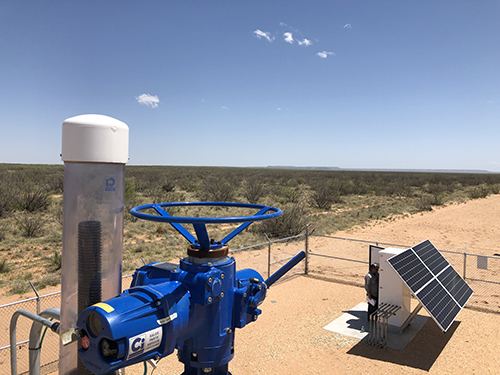Powering Remote Valve Stations: Best Practices
What You Need to Know About Solar and UPS Power for Valve Actuation
By Andre Scholtz, Technical Director at Solarcraft, Inc.

Valve actuators, especially for Rupture Mitigation Valves (RMVs) Automatic Shut-off Valves (ASVs), and Remote-Control Valves (RCVs), are required along the vast stretches of pipeline infrastructure in America. Pipelines pass through remote areas where utility line power can be less than dependable, costly to install on-site, or unavailable. That’s where Solar Power Systems can provide both the power and reliability to remotely operate a valve in the event of an emergency.
Energy Reserves & Back-Up
In reviewing energy requirements first, a typical remote valve actuator site will have a communication component, whether licensed radio, cellular, or satellite. This same site will likely have a PLC or SCADA system. In the event of a power failure, several days of battery backup power is recommended, especially if the power failure is weather-related. This gives technicians enough time to get to the site once the weather clears.
In the case of a solar-powered system, five days or more of battery backup power (autonomy) is required for proper system function during inclement weather, and to ensure the daily discharge is no more than 20% of the battery’s capacity.
Assuming a 40-Watt load for PLC, SCADA, and Communications, all operating at 24VDC, a system requires 200 Amp-hours of battery capacity. This value increases to 313 Amp-hours when the battery is properly derated for depth of discharge and end-of-life capacity, and even more when it is destined for cold climates.
Understanding Power vs. Energy
The instantaneous power required by a valve actuator depends on the application. Electric motors from less than one horsepower to several 10s of horsepower are common. While the power requirements vary widely, what is common across the spectrum is the relatively small amount of energy required to operate a valve. For example, a 10-horsepower actuator operating over a 2-minute cycle requires about 250 Watt-hours of energy. Converting this value to Amp-hours in a 24VDC battery while accounting for DC-AC conversion losses, about 14 Amp-hours are consumed when closing a large valve in a hurry. When compared to the continuous load on the system, an occasional load like this is considered a small amount of energy.
However, we must keep in mind what the maximum current demand on the battery bank will be when calculating its size. To start a 10hp actuator, the inverter may draw upwards of 1000A from a 48V battery bank for a fraction of a second when starting up, requiring careful thought in selecting components like cables, circuit breakers, and battery chemistry.
Inverter Sizing Is Critical
The power requirements of a remote actuator system are an entirely different matter; especially where standard AC motors drive the actuator. AC motors, whether single-phase or 3-phase, require an inverter that can supply most of the published locked-rotor current of the motor. Locked-rotor current (LRA) can simply be considered the “starting” current of the motor, usually somewhere between 4 to 10 times the “running” current (FLA). Because actuators may sit for extended periods between operating cycles, static friction in the mechanism becomes a factor in starting. Ensuring that sufficient current is available to start the locked rotor and overcome friction is vital.
Supplying the entire locked-rotor current rating of the actuator motor is not necessary. Experience has taught me that the maximum current capability of the inverter should be 6 times the running current of the motor. Solarcraft Best Practice calls for inverters that deliver two times their rated output for a duration of 3 seconds; this is sufficient to overcome the demand for starting current. Therefore, a good rule-of-thumb is to provide 3 kilowatts of inverter power for each horsepower of the actuator motor. For example, an 8-horsepower motor requires a 24-kilowatt inverter. The inverters are modular and can be configured for power output, single, split, and 3-phase operation. However, these inverters are a major component of the overall system cost.
Alternatives to Consider When Specifying an Actuator
Depending on the size of the valve and the stroke time required, there are alternatives to consider. Several actuator manufacturers offer 24/48 Volt DC-powered versions. These eliminate the need for an inverter altogether because system batteries are more than capable of supplying starting currents. A 24/48 Volt DC actuator offers substantial cost advantages and should be considered wherever a smaller actuator is required. 110 Volt AC versions are also available but should be avoided for solar-powered systems since the same torque and power numbers are typically available in DC units, and one can do the same work without introducing the complexity and additional points of failure found in AC systems.
Depending on the actuator size (2-3 horsepower or less), a single-phase motor can be chosen over a 3-phase. While the single-phase motor is a bit more expensive, the inverter to power it is less complicated and more than offsets the increase in motor cost.
A Word of Caution
When designing safety valve systems on pipelines, it is extremely important to resist the temptation to build a system with commonly available commercial inverters and other low-cost components. Be sure to take great care in providing engineering input to your suppliers to ensure that your systems can take repeated hammerings from induction motors, often through transformers, in particularly hostile environments.
To talk to a specialist about your application, contact Solarcraft, Inc. at sales@solarcraft.net or call 877.340.1224.
Solarcraft.net | 12300 Dairy Ashford Road. STE 100 | Sugar Land TX 77478

